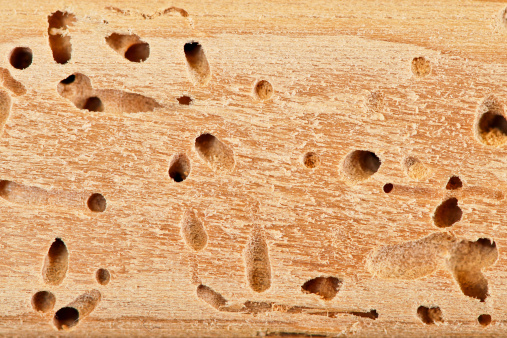
Termite hole close-up. (Getty Images)
You’re finding little holes around your home. You wonder what they are. You Google, “What do termite holes look like?” And here you are.
First, let us say no matter where you are, give us a call and describe what you’re seeing (or take a picture or video!), and we can help you determine if you need the help of a pest control specialist.
Next, it’s actually important to understand that there are different types of termites. Some termites, called drywood termites, are the kind that typically leave holes. (More on how and why in a minute.)
But other termites -- like subterranean termites -- don’t leave holes but can cause a ton of damage to your home. We don’t mean to stoke your anxiety, but whether or not you conclude the holes in your walls are from thumbtacks or termites, you may not be in the clear just yet.
Termites are wood-eating, moisture-seeking, destructive pests and they’re active year-round. To help protect your home from termites, it’s important to understand what kind of damages termites can cause and what signs to look out for beyond just termite holes, so that in the event of an infestation, you can call for professional help as soon as possible. (Especially with the formosan termite, an invasive species in the South Georgia/North Florida region that inflicts tremendous damage in a short amount of time.)
Common warning signs of a termite infestation include:
Swarming
After swarming from the colony, reproductive termites quickly lose their wings and so they don’t travel very far. So if you’re seeing swarming termites, there’s probably a mature nest nearby.
Mud tubes
Termites travel back and forth from their nest to their food sources. They use tubes to protect themselves from weather and predators.
Droppings
You might see droppings on the floors in different areas of your home. The droppings resemble bird seed — and kind of smell like it, too.
Bubbling or splintering
If you see damage that looks like splintering or bubbling along the baseboards or drywall, or if your doors and windows aren’t opening or closing properly, you may have an infestation. A bad infestation may even cause your floors and ceilings to sag. (Yeah. It’s serious.)
Unfortunately, by the time any signs of a termite infestation are discovered, significant damage has already been done. So termite holes are a sign of pretty severe progression of an infestation. The termites may have already created tunnels throughout the structural wood of your home.
Why do drywood termites make holes?
Drywood termites don't have to have connection with soil. So they're able to squeeze the wood with their gut and get moisture out of it that way. These holes aren’t actually called termite holes, technically. They’re called “kick-out holes.” The wood kicked out looks like mustard seeds, and you can see grooves where their gut has squeezed out the moisture. If you’re wondering if what you’re looking at could be termite holes (or kick-out holes), look for a pile of these tiny wood seeds on the floor. Chances are you’ll be sweeping them up for months before you realize you could have a termite problem on your hands.
We don’t want to scare you! But we do want to give you peace of mind. Call Dixon Pest Services today and we’ll make sure you and your home are safe from termites.